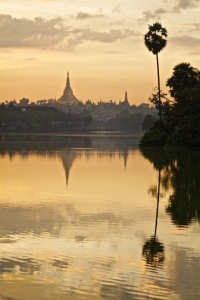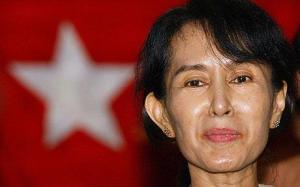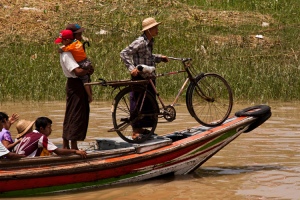
At the upcoming Young Global Leaders Annual Summit at the World Economic Forum for East Asia in Myanmar (Burma), I, along with two of my colleagues, Shoukei Matsumoto and Thura Ko, will be running an Impact Journey on Spirituality and Mindful Leadership for our fellow YGLs.
I was first inspired to propose a workshop on this after feeling disappointed that the majority of discussion on this topic at Davos tended to focus most on what I consider to be the politics of religion, rather than the power of spirituality. After one particular panel discussion, I posed to the audience the question of what it would mean if global leaders with a commitment to spiritual thinking were to share their experiences of bringing healing to their communities. After all, what else is the purpose of religion and spirituality if not to bring healing?
I was further encouraged after reading an article, Freedom from Fear, by Aung San Suu Kyi, Myanmar’s celebrated pro-democracy leader and Nobel Peace laureate.

In the article, Aung San Suu Kyi articulates the need for there to be a ‘revolution of the spirit’ if we are to overcome the challenges of leading in today’s world.
In my own life, spiritual vision has been fundamental to my leadership journey. Like many others, I take the approach of ‘servant leadership’, that I feel compelled to do what I do [in my case, using arts for social change] as part of a bigger vision of healing for the world. I have come to learn, through the trials and tribulations of my own experiences and observing the experiences of others, that what defines a leader is not so much the particularities of what he or she does, and the successes and failures, achievements and mistakes they encounter along the way, so much as their individual commitment to continue to strive for this higher vision of humanity, irrespective of the material circumstances and ‘crucibles’ they face. Aung San Suu Kyi, as we know, is an exemplary model for such leadership.
The schedule for our Impact Journey will take us to the Myanmar Institute of Theology, Schwedagon Pagoda and the Sitagu International Buddhist Academy and will encompass an opportunity for meditation and reflection on the following two key questions:
1) How have you used spirituality in your leadership? What universal ‘principles’, that transcend any one individual faith, have enabled you to bring healing to your communities?
2) What ‘value’ do spiritual and religious institutions hold in society today? And how can we ‘measure’ that value?
We are also aiming to weave in the concept of feminine leadership to the discussion, in light of Aung San Suu Kyi’s leadership, and the imperative that exists to bring gender issues into the discussion.
In anticipation of a fruitful and inspiring Impact Journey, and in a spirit of inquiry to prepare us for the experience, I invite you all – friends, family, fellow YGLs and colleagues – to leave your comments and thoughts on these two central questions. We’d love to hear your stories of how you have used spirituality in your own leadership journey and to further the discussion of what value spiritual and religious institutions have in society today. Please leave your comments below and we look forward to the continued sharing of these ideas.
- Myanmar by bsmethers

Great and inspiring!
I just want to share some ideas that came to mind after reading your blog. In fact, these two questions reminded me of some articles I’ve read lately about what defines the “value” of an action or a project. These articles suggest that before asking about “what” to do, we should ask “why” and “how”. As you say, what defines a leader is not so much what she/he does, but their highest vision of humanity. For me this is the “why”, the motives behind an action. And in your blog on female leadership you talk about the importance of the simultaneous expression of feminine and masculine qualities in a leader. In other words, you show the relevance of the “how”. The “what” would then be a subsequent unfolding to the answer to these two central questions. So, in this context, the role of spirituality would be to provide elevated responses to the “why” and to the “how”. This could be seen as an important part of the definition of the “value” of spiritual and religious institutions. And once we have clarity about the “why” and the “how”, the “what” becomes clearer and more effective, which then allows us to think in concrete actions concerning politics and other important topics.
Thanks for this intro Caroline. Your focus on spiritual leadership for healing communities reminded me of a book I read recently called “Religion for Atheists” by Alain De Botton, where he talks about the the value of religions in providing “ideas on how we might live and arrange our societies”, with the aim of applying some of these religious or spiritual ideas in a secular context.
Personally, I’d add that the topics of spirituality and leadership at their best exhibit qualities of humility and ‘the beginners mind’, which both seem necessary to counteract the arrogance and overconfidence that remains dominant (and often demanded) among leaders of today.
Another aspect of spirituality that might be worth bringing into a discussion on leadership is the importance of presence – experiencing the sense of richness and interconnectedness of the present moment. Leadership often entails being preoccupied with planning for the future or evaluating the past, however the best decisions are often made when can really be present with the people we work and live with. Many spiritual (especially mystical) traditions invite us to stop and look, seeing the boundaries of our “self” dissolving in the connections with other beings and ecosystems and reaching a healthy mix of being and doing, accepting and growing.